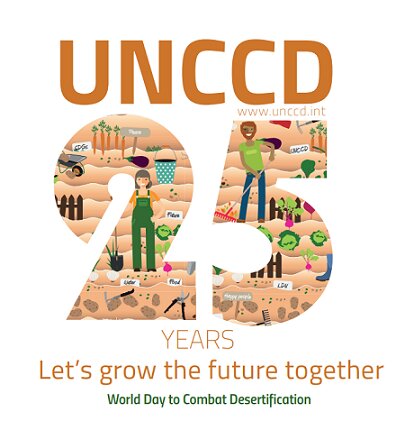Biodiversity & Environment
World Day to Combat Desertification and Drought
- 18 Jun 2019
- 7 min read
The World Day to Combat Desertification and Drought is observed every year on 17th June. India for the first time will host the 14th session of the Conference of Parties (COP-14) of the United Nations Convention to Combat Desertification (UNCCD) in September, 2019.
- The World Day to Combat Desertification and Drought is observed every year to promote public awareness of international efforts to combat desertification.
- The day is a unique moment to remind everyone that land degradation neutrality is achievable through problem-solving, strong community involvement and cooperation at all levels.
- The Theme of 2019 is “Let’s Grow the Future Together”
United Nations Convention to Combat Desertification (UNCCD)
- It was established in 1994, the sole legally binding international agreement linking environment and development to sustainable land management. The Convention addresses specifically the arid, semi-arid and dry sub-humid areas, known as the drylands, where some of the most vulnerable ecosystems and peoples can be found.
- UNCCD 2018-2030 Strategic Framework: It is the most comprehensive global commitment to achieve Land Degradation Neutrality (LDN) in order to restore the productivity of vast expanses of degraded land, improve the livelihoods of more than 1.3 billion people, and reduce the impacts of drought on vulnerable populations to build.
- The Convention’s 197 parties work together to improve the living conditions for people in drylands, to maintain and restore land and soil productivity, and to mitigate the effects of drought.
- The UNCCD is particularly committed to a bottom-up approach, encouraging the participation of local people in combating desertification and land degradation. The UNCCD secretariat facilitates cooperation between developed and developing countries, particularly around knowledge and technology transfer for sustainable land management.
- As the dynamics of land, climate and biodiversity are intimately connected, to meet these complex challenges with an integrated approach and the best possible use of natural resources. The UNCCD collaborates closely with the other two Rio Conventions:
- The Convention on Biological Diversity (CBD).
- The United Nations Framework Convention on Climate Change (UNFCCC).
The Conference of the Parties (COP)
- The COP was established by the Convention as the supreme decision-making body. It comprises ratifying governments and regional economic integration organizations, such as the European Union.
- Functions of COP: One of the main functions of the COP is to review reports submitted by the Parties detailing how they are carrying out their commitments.
- The COP makes recommendations on the basis of these reports.
- It also has the power to make amendments to the Convention or to adopt new annexes, such as additional regional implementation annexes.
- The COP can guide the Convention as global circumstances and national needs change.
UNCCD Estimate of Desertification
- Land & Drought: By 2025, 1.8 billion people will experience absolute water scarcity, and 2/3 of the world will be living under water-stressed conditions.
- A complex and slowly encroaching natural hazard with significant and pervasive socio-economic and environmental impacts to cause more deaths and displace more people than any other natural disaster.
- Land & Human Security: By 2045 some 135 million people may be displaced as a result of desertification.
- Achieving land degradation neutrality -by rehabilitating already degraded land, scaling up sustainable land management and accelerating restoration initiatives- is a pathway to greater resilience and security for all.
- Land & Climate: Restoring the soils of degraded ecosystems has the potential to store up to 3 billion tons of carbon annually.
- The land use sector represents almost 25% of total global emissions. Its rehabilitation and sustainable management are critical to combating climate change.
UNCCD and Sustainable Development
- Goal 15 of Sustainable Development Goals(SDG), 2030 declares that “we are determined to protect the planet from degradation, including through sustainable consumption and production, sustainably managing its natural resources and taking urgent action on climate change, so that it can support the needs of the present and future generations”.
India and UNCCD
- The Union Ministry of Environment, Forest and Climate Change (MoEFCC) in partnership with the International Union for Conservation of Nature (IUCN) also launched a flagship project on enhancing capacity on forest Landscape Restoration (FLR) and Bonn Challenge in India, through a pilot phase of 3.5 years implemented in the States of Haryana, Madhya Pradesh, Maharashtra, Nagaland and Karnataka.
Desertification
- It is the degradation of land in arid, semi-arid and dry sub-humid areas. It is caused primarily by human activities and climatic variations. Desertification does not refer to the expansion of existing deserts.
- It occurs because dryland ecosystems, which cover over one-third of the world‘s land area, are extremely vulnerable to overexploitation and inappropriate land use.
- Poverty, political instability, deforestation, overgrazing and bad irrigation practices can all undermine the productivity of the land
Bonn challenge
- The Bonn Challenge is a global effort to bring 150 million hectares of the world’s deforested and degraded land into restoration by 2020, and 350 million hectares by 2030.
- At the UNFCCC Conference of the Parties (COP) 2015 in Paris, India also joined the voluntary Bonn Challenge pledge to bring into restoration 13 million hectares of degraded and deforested land by the year 2020, an additional 8 million hectares by 2030.
- India’s pledge is one of the largest in Asia.




